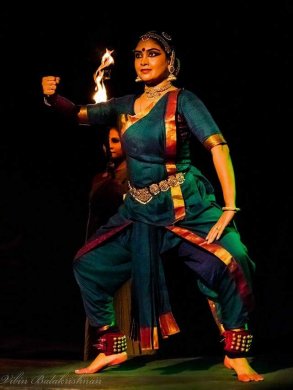
|   |

|   |
Lanka Lakshmi -Padma Jayaraj e-mail: padmajayaraj@gmail.com February 17, 2018 A Book Festival is a regular annual event that Kerala Sahitya Akademi offers to the public in Thrissur. Seminars and cultural activities are part of the 10-day experience. Of the many presentations the dance drama ‘Lanka Lakshmi’ presented by Rajashree Warrier on 8th Feb 2018 was remarkable. Rajashree, familiar as a Bharatanatyam dancer for the past two decades, has proved her mettle not only on stage but also as a writer with the publication of her two books Nruthakala and Narthaki.  Lanka Lakshmi, a dance drama built on the grammar of Bharatanatyam, was a brave attempt to showcase a work in Malayalam literature. The piece begins with a prologue that pays tribute to the author of the text, C.N. Sreekandhan Nair, a doyen of Malayalam Theatre. Lanka Lakshmi is the second work of his trilogy, based on the Ramayana. The dance drama opens in a heightened dramatic moment, of Lanka Lakshmi receiving a slap on her face from Hanuman, who has just reached Lanka in search of Sita. A struggle ensues. After the shocking defeat, she realizes that she is now free of her curse that made her the guardian of Ravana’s land. So, she tells Hanuman where he can find Sita. Hanuman sets out admiring the beauty of Lanka on his way to Asoka vanam. The dancer paints the stately abode of King Ravan based on the passages from Adhyathma Ramayanam by Thunjath Ramanujan Ezhuthachan, the father of Malayalam literature. In a flash back, the events that led to the abduction of Sita (the manhandling of Surpanakha, the deception of the golden deer, death of Maricha, abduction of Sita) unravel connecting the past and the present. The story weaves in and out in delicate charm. The bare backdrop and somber costume make the dance brilliant in a subtle manner. The orchestra highlights the chemistry of restrained abhinaya in a fascinating style. Veena plays the upper hand throughout the rendering. The superb team included Dr. Sridevi (nattuvangam), Reju Narayanan (vocal), Sreerang (mridangam) and V. Soundararajan (veena). The verses penned by B.K. Hari Narayanan, an established lyricist in Malayalam film world, are set to music by the dancer herself. The credit for choreography too goes to her. The second half initiates the drama phase. Dialogic in nature, the brothers Ravana and Vibhishana, debate on the pros and cons of the event that makes war inevitable. It’s a beautiful flow of rhythmic verses that underscores a Tamil theatre tradition called pesal. While Vibhishana sounds like a preacher, Ravana rises up in heroic dimensions. He dismisses Vibhishana reminding him that as a traitor he deserves death as punishment. But Ravana will grant his brother his choice.  Soon word reaches the King of Lanka of the death of Prahasthan, his right-hand in battlefield. Enraged, he rushes to the field only to see Vibhishana among the enemy ranks. Crushed, Ravana staggers under the pain of love and deceit, the beginning of his defeat. Mandodari, the wife of Ravana, tries to reason with him in great compassion. The king, torn and wounded, both physically and mentally, forgets himself as the report of the death of Kumbhakarna and Indrajith reaches him. The inevitable tragic fall is presented in a beautiful manner in folk format. Two flaming torches in the interplay of light and darkness, projects the fighting of Ravana in minimal art. The Dravidian features of folk theatre and music known as chindu adds to the grandeur of Ravana, and his tribal ethos in slow moving dance. The war wipes out the entire family, men and women, without any ethical concerns, a symbolic and ironic representation of any war since the Rama-Ravana encounter in India’s celebrated epic. The silent backdrop negates all glory. The finale is another unexpected shot. Sita, seeing Rama is elated, her thrill of joy displayed in feminine charm gets instantly clouded under the stern gaze of Rama’s disapproving glance. We understand the consequence, her trial by fire, agnipravesam, the price women pay in a patriarchal world. Sita has seen the other side of the coin. Experience under great trauma has revealed the innate goodness in Lanka. As Sita follows Rama, she carries the imprint of Lanka and Ravana in her scalding soul; the daughter of Mother Earth leaves carrying a handful of dust, casting a lingering backward glance. A poignant end with a great philosophy! At a subtler level, Lanka Lakshmi is the story of three women: the guardian deity of Lanka, Mandodari and Sita. A red piece of cloth in costume change (the garment associated with the primordial Kaali, the tribal Mother Goddess of Kerala) binds them symbolically. Red and black relieved by fire evoke the quintessence of Dravidian art in cult practices. The theme of Lanka Lakshmi is rounded off as Sita leaves Lanka. But Sita carries the legacy, a handful-of-dust into future history. “Actually my interpretation of Sita and Ravana surpasses the original play. Rather it goes beyond,” says Rajashree. “Dance and music convey this abstract strand that narrates the evolution of understanding and respect between Sita and Ravana for each other as two noble human beings.” Uthara Ramayanam is yet to come. The choreography takes us to future where Sita’s just stand is the first knock that patriarchy receives in the history of feminist interpretation of the Ramayana, long before the term feminism came to the fore. Textually, the last scene is the prologue to Kanchana Sita, the last of C.N. Sreekandhan Nair’s trilogy. The attempts at lighting by Sivan Venkidangu was not a success on a make-shift stage though glimpses of it showed an underlying brilliant concept of Rajashree’s light design. The production just beginning its voyage has a promising future as it unfolds and evolves through many venues. Padma Jayaraj is a freelance writer on the arts and a regular contributor to www.narthaki.com. |